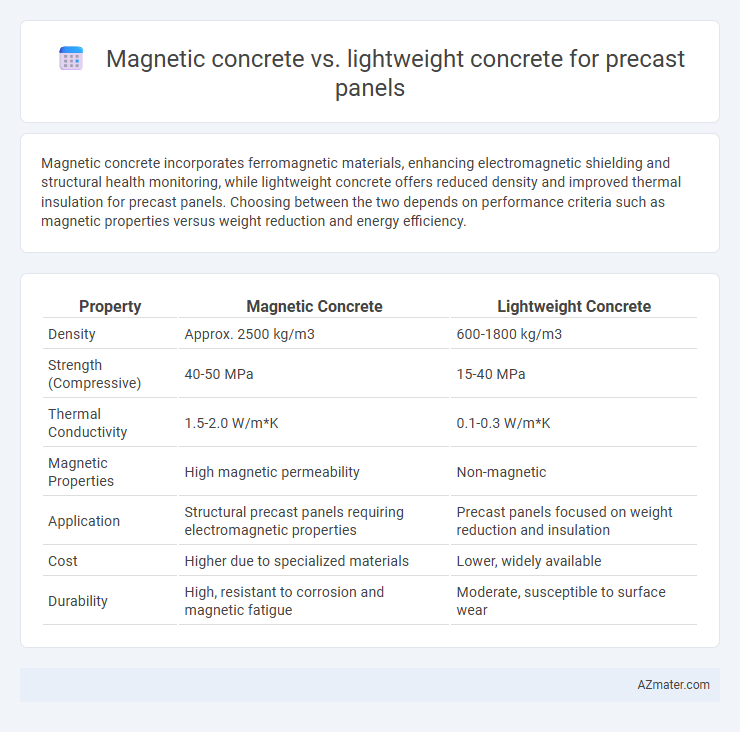Magnetic concrete incorporates ferromagnetic materials, enhancing electromagnetic shielding and structural health monitoring, while lightweight concrete offers reduced density and improved thermal insulation for precast panels. Choosing between the two depends on performance criteria such as magnetic properties versus weight reduction and energy efficiency.
Table of Comparison
| Property | Magnetic Concrete | Lightweight Concrete |
|---|---|---|
| Density | Approx. 2500 kg/m3 | 600-1800 kg/m3 |
| Strength (Compressive) | 40-50 MPa | 15-40 MPa |
| Thermal Conductivity | 1.5-2.0 W/m*K | 0.1-0.3 W/m*K |
| Magnetic Properties | High magnetic permeability | Non-magnetic |
| Application | Structural precast panels requiring electromagnetic properties | Precast panels focused on weight reduction and insulation |
| Cost | Higher due to specialized materials | Lower, widely available |
| Durability | High, resistant to corrosion and magnetic fatigue | Moderate, susceptible to surface wear |
Introduction to Precast Concrete Panels
Precast concrete panels, widely utilized in modern construction, offer enhanced durability and quality control by being manufactured off-site in controlled environments. Magnetic concrete incorporates magnetic particles to improve structural performance and electromagnetic shielding, while lightweight concrete reduces dead load through the use of low-density aggregates like expanded clay or shale. Both types optimize specific engineering requirements in precast panels, with magnetic concrete focusing on functional properties and lightweight concrete emphasizing ease of handling and thermal insulation.
What is Magnetic Concrete?
Magnetic concrete is a type of composite material infused with ferromagnetic particles such as iron or steel powders, enabling it to exhibit magnetic properties. This concrete variant enhances structural functions by allowing electromagnetic sensors to monitor stress and detect damages within precast panels. Compared to lightweight concrete, which prioritizes reduced density and insulation, magnetic concrete offers advanced capabilities for smart infrastructure and improved durability in precast panel applications.
What is Lightweight Concrete?
Lightweight concrete is a type of concrete that incorporates lightweight aggregates such as expanded clay, shale, or pumice, resulting in reduced density and improved thermal insulation properties perfect for precast panels. It offers enhanced workability, lower structural load, and better fire resistance compared to conventional concrete, making it ideal for building facades and non-load-bearing walls. Magnetic concrete, by contrast, integrates ferromagnetic materials to achieve specific electromagnetic properties, but lightweight concrete remains preferred for applications prioritizing weight reduction and thermal efficiency.
Material Composition Comparison
Magnetic concrete integrates ferromagnetic materials such as iron ore or steel fibers, enhancing electromagnetic properties critical for structural health monitoring in precast panels. Lightweight concrete primarily uses lightweight aggregates like expanded clay or pumice to reduce density, improving thermal insulation and easing handling without significantly compromising strength. The contrasting material compositions influence the precast panel's functional performance, with magnetic concrete offering smart structural capabilities and lightweight concrete providing improved thermal efficiency and reduced dead load.
Strength and Durability Differences
Magnetic concrete exhibits higher compressive strength and enhanced durability due to the incorporation of ferromagnetic materials, which improve its density and resistance to cracking compared to lightweight concrete. Lightweight concrete offers reduced structural load and better thermal insulation but typically has lower strength and durability, making it less suitable for high-stress precast panels. For precast panels requiring superior load-bearing capacity and long-term performance, magnetic concrete provides a more robust and durable solution.
Installation and Handling Efficiency
Magnetic concrete offers superior installation efficiency in precast panels due to its enhanced magnetic properties, enabling quicker alignment and secure positioning without extensive mechanical fasteners. Lightweight concrete significantly reduces handling time and labor costs by lowering panel weight, facilitating easier transportation and safer manual or mechanical handling on-site. Comparing both, magnetic concrete excels in precision and stability during installation, while lightweight concrete prioritizes reduced effort and speed in handling processes.
Cost Analysis: Magnetic vs. Lightweight Concrete
Magnetic concrete typically incurs higher initial material costs due to specialized additives like iron particles, whereas lightweight concrete benefits from lower raw material expenses by incorporating lightweight aggregates such as expanded clay or shale. In terms of production, lightweight concrete panels often require less energy for curing and handling because of reduced density, which can lead to decreased transportation and labor costs compared to magnetic concrete. Over the lifecycle, magnetic concrete may provide added value through enhanced structural performance or electromagnetic properties, but lightweight concrete generally offers more cost-effective solutions for precast panels focused on weight reduction and thermal insulation.
Insulation and Thermal Properties
Magnetic concrete typically incorporates magnetic particles, offering enhanced durability but generally lower thermal insulation compared to lightweight concrete, which contains air-entraining aggregates that significantly improve insulation performance. Lightweight concrete exhibits superior thermal resistance and energy efficiency in precast panels, reducing heat transfer and enhancing indoor comfort. The choice between magnetic and lightweight concrete depends on balancing structural strength with thermal insulation requirements for optimal precast panel performance.
Applications in Modern Construction
Magnetic concrete enhances structural monitoring and electromagnetic shielding in precast panels, ideal for smart buildings and infrastructure requiring real-time health assessment. Lightweight concrete reduces panel weight without compromising strength, facilitating faster installation and improved thermal insulation in high-rise and modular constructions. Both materials optimize performance, with magnetic concrete suited for advanced technological applications and lightweight concrete preferred for energy-efficient, cost-effective building solutions.
Sustainability and Environmental Impact
Magnetic concrete for precast panels offers enhanced recyclability by integrating ferromagnetic materials, allowing efficient separation and reuse, thereby reducing construction waste and environmental footprint. In contrast, lightweight concrete reduces structural load and energy consumption in transportation and handling due to its lower density, contributing to decreased carbon emissions over the building lifecycle. Both materials improve sustainability by optimizing resource use, yet magnetic concrete's recyclability presents a notable advantage in circular construction practices.

Infographic: Magnetic concrete vs Lightweight concrete for Precast panel
 azmater.com
azmater.com